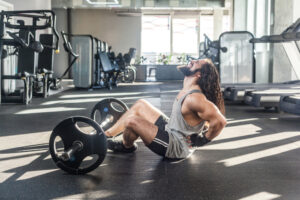 A good workout can tend to leave you sore afterward, however, your back should not take the brunt of your pain during or after your workout. If your pain continues, contact us for our services to get you back to feeling your best! Here are some ways you can recognize and save your back from pain after a workout.
A good workout can tend to leave you sore afterward, however, your back should not take the brunt of your pain during or after your workout. If your pain continues, contact us for our services to get you back to feeling your best! Here are some ways you can recognize and save your back from pain after a workout.
“Dealing with post-workout lower back pain? Discover the causes and solutions. Prevent future discomfort with expert tips and exercises. Take control today!”
Experiencing soreness post-workout is normal. However, persistent lower back pain post-workout may indicate underlying conditions. We tend to engage in exercises without the awareness of basics, including posture, weights, and intensity. Ignoring such factors counteracts the goal of working out and leads to injuries. Hence, before you work out, take the time to understand your body’s needs and be mindful of possible injuries or discomfort.
Understanding Lower Back Pain After a Workout
We assume that workouts increase strength, flexibility, mobility, and general functionality. However, like any other activity, excessively engaging in the same or not following healthy exercise habits can harm one’s fitness. According to the U.S. Department of Health and Human Services, most people injure their backs when they suddenly engage in high-intensity lifting. Further, poor posture during exercise can aggravate pre existing conditions like spinal issues.
When Lower Back Pain After a Workout is Normal?
Feeling tightness or tension in the lower back is expected after a particular exercise. For instance, deadlifts and squats activate the rear muscles, leading to stress. Further, a dull ache or soreness is a common consequence of workouts. These symptoms can be explained by delayed-onset muscle soreness (DOMS). Our body’s natural inflammatory response to exercise causes subtle strain on the muscles and connective tissues. You may have observed that back DOMS (lower back pain) develops gradually after exercise. It may develop within 6 to 8 hours after a workout, with it reaching a peak at around 24 to 48 hours, and finally diminishing in approximately 72 hours.
When Lower Back Pain After Workout Becomes a Concern
It is important to know that not all forms of lower back pain are typical. Feeling a sharp pain after your workout or persistent pain in a specific area is not normal. This form of acute pain during and immediately after your workout can be a symptom of a back injury. Further, with such damages, the pain tends to persist 72 to 96 hours post-exercise. In addition to general pain, accompanying signs may aggravate the pain and the condition. For instance, some recognizable signs include tenderness, pain spreading to other body regions, weakness, and inflammation.
Causes of Lower Back Pain Post-Workout
Poor exercise habits, old injuries, lifting heavy weights, and more are part of a longer list of factors that can cause lower back pain.
Overuse injuries
Doubling down on a specific area repeatedly leads to wear and tear of muscles and joints in that region. This eventually results in inflammation, weakness, and severe pain. This is why experts recommend including exercises focusing on different muscle groups in your workout regime.
Poor posture
Having poor form while lifting weights or engaging in form of exercise can strain or injure the ligaments and muscles of the back. It may also exert pressure on the spine and joints leading to alignment issues, fractures, dislocations, and more.
Weak core muscles
The core muscles play a major role in maintaining the strength and stability of the back. It includes the front abdominal muscles, muscles on the side of the body, back muscles that run along the spine, and the transverse abdominal surrounding the front and back muscles. Following exercise regimes that do not activate or strengthen the core muscles adds to general back pain that may worsen over time.
Dehydration
Dehydrating before, during, or after a workout can lead to severe lower back pain. The fluid-filled cavities in each disc support and nourish the spine. However, dehydration reduces the amount of fluid, leading to stress, inflammation, and pain.
Pre Existing conditions
Exercising while tackling preexisting conditions like arthritis, osteoporosis, herniated discs, ligament strain, and more can aggravate the pain. Hence modifying your workout regime around the preexisting condition is essential to avoid further pain and injury.
Treatment Options for Lower Back Pain After a Workout
Experts recommend several home remedies and specialized treatment plans to cope with lower back pain post-workout.
Rest and Ice
Taking a break and giving your back the rest it needs is essential to avoid overstraining. Further, applying ice for at least 20 minutes can help reduce tightness, inflammation, and pain in the lower back. Keep in mind that as you apply ice, wrap it in a cloth to avoid frostbite.
Pain Medications
As medical experts prescribe, several medications like Nonsteroidal anti-inflammatory drugs (NSAIDs) and muscle relaxants can temporarily relieve pain and inflammation. However, pain medications are only effective when combined with other treatment forms.
Physical Therapy
Our physiotherapists say stretching and strengthening exercises can help reduce pain, tightness, and tension. Further, it can improve flexibility, strength, and range of motion associated with the lower back. In addition to treatment, physiotherapists also take the time to educate their clients on basic lifestyle changes that help avoid such conditions and improve their overall well-being.
Click here to learn more prevention techniques and to keep reading
Original article published on physiotattva.com







